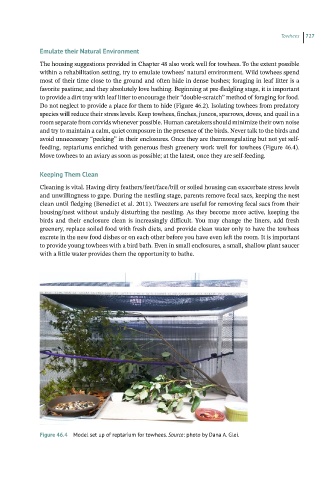Page 725 - Hand rearing birds second
P. 725
Towhees 727
Emulate their Natural Environment
The housing suggestions provided in Chapter 48 also work well for towhees. To the extent possible
within a rehabilitation setting, try to emulate towhees’ natural environment. Wild towhees spend
most of their time close to the ground and often hide in dense bushes; foraging in leaf litter is a
favorite pastime; and they absolutely love bathing. Beginning at pre‐fledgling stage, it is important
to provide a dirt tray with leaf litter to encourage their “double‐scratch” method of foraging for food.
Do not neglect to provide a place for them to hide (Figure 46.2). Isolating towhees from predatory
species will reduce their stress levels. Keep towhees, finches, juncos, sparrows, doves, and quail in a
room separate from corvids whenever possible. Human caretakers should minimize their own noise
and try to maintain a calm, quiet composure in the presence of the birds. Never talk to the birds and
avoid unnecessary “peeking” in their enclosures. Once they are thermoregulating but not yet self‐
feeding, reptariums enriched with generous fresh greenery work well for towhees (Figure 46.4).
Move towhees to an aviary as soon as possible; at the latest, once they are self‐feeding.
Keeping Them Clean
Cleaning is vital. Having dirty feathers/feet/face/bill or soiled housing can exacerbate stress levels
and unwillingness to gape. During the nestling stage, parents remove fecal sacs, keeping the nest
clean until fledging (Benedict et al. 2011). Tweezers are useful for removing fecal sacs from their
housing/nest without unduly disturbing the nestling. As they become more active, keeping the
birds and their enclosure clean is increasingly difficult. You may change the liners, add fresh
greenery, replace soiled food with fresh diets, and provide clean water only to have the towhees
excrete in the new food dishes or on each other before you have even left the room. It is important
to provide young towhees with a bird bath. Even in small enclosures, a small, shallow plant saucer
with a little water provides them the opportunity to bathe.
Figure 46.4 Model set up of reptarium for towhees. Source: photo by Dana A. Glei.

